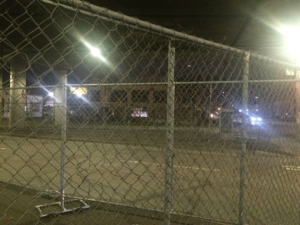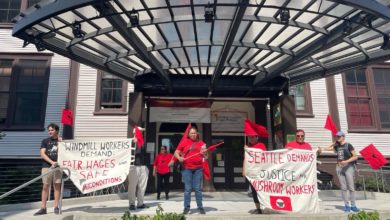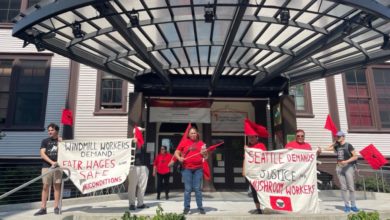
As of June 30, the City of Seattle planned to spend at least $1.1 million on the task of keeping homeless people from sleeping under bridges. Most recently, fencing was erected under the Spokane Street Viaduct in SODO, stretching almost two miles. The fencing under the Viaduct is over ten feet tall, with small mesh and blades spaced along the top in a manner the Seattle Times described as “discreet.” Clearly the city is choosing to use hard-to-see deterrents at the cost of an increased risk of severe injuries to fence jumpers.
The King County Transportation Department cites a concern for the safety of the homeless and other community members as a justification for these draconian measures. The bizarre logic of forcing homeless people out into the biting cold and wet in the name of “safety” highlights the cynicism and hostility with which the city government treats the houseless population.
The new fencing and the recent surge in sweeps of homeless encampments come in the wake of other anti-homeless measures that the city of Seattle has instituted. In some areas of the city, it is illegal to sit down on a sidewalk between 7 am and 9 pm.
Along the same lines, throughout the city, you can see benches subtly designed to discourage or prevent people from sleeping on them. Some are excessively narrow and backless, some are divided in half with metal, some are shaped oddly or tilted backwards. Some of the newer LINK Light Rail stations utilize individual seats instead of benches, or have done away with seating entirely. It seems there is an endless number of new and creative ways to force people to sleep on the ground.
Seattle also has various laws against panhandling, sleeping in vehicles, and “loitering,” a vague charge clearly designed for selective enforcement.
Advocates for the homeless have debated the merits of directing more funding towards transitional housing versus “rapid re-housing,” a term for the use of short-term subsidies to get people into apartments in the hope that they will be “back on their feet” before the subsidy runs out.
One thing is clear: Either of these housing strategies would be preferable to investing millions in blocking off empty, unused space and performing sweeps of tent cities and other encampments.
Two years ago, former Seattle mayor Ed Murray declared a “state of emergency” regarding homelessness. Today, the actual meaning of that phrase remains unclear. $50 million was spent in 2016, and yet a one-night count of homeless people (on the streets, in encampments, in cars, or in transitional housing) showed about a thousand more homeless individuals across King County in 2017 than were counted in 2016.
Statistics like these have shown rapid increases for the last several years. The “efforts” the city is making aren’t helping homeless people get housed or lead better lives. In fact, the effect of sweeps and fencing off covered areas has been overwhelmingly harmful. Measures that criminalize homelessness and prevent people from using empty space don’t do anything to “solve homelessness.” A fence under the Spokane Street Viaduct will not keep people from sleeping on the ground, and it certainly will not make anybody safer. So why do it, especially when it costs so much money?
Business owner Mark Benezra of Buffalo Industries LLC. in SODO discussed the presence of homeless encampments in the neighborhood as having made him feel “uncomfortable” on local station KOMO: “The fencing has been an improvement, at least as far as we’re concerned, and I think a lot of the property owners down in SODO feel the same way.”
This is the motive force driving these anti-homeless measures: business owners and landlords. It has nothing to do with the safety of either the homeless themselves or the people who live and work near them, and it never has been.
There is no real solution to homelessness in the capitalist housing market, where thousands of homes sit empty and thousands of people sleep on the sidewalk. Recent research has shown that income inequality in Seattle is the worst in the nation, that a 10 percent rent increase in Seattle results in 523 more homeless people; that a family of four needs an income of $76,000 a year just to manage to live a bare-bones existence in the Emerald City. “Sweeping” homeless people from one area to another–as if they are trash– cannot possibly resolve the true state of emergency that exists in this city. Dramatic measures are needed that will put people’s needs first over the profits of the landlords and developers.
Ultimately, it will only be by establishing the right to housing for all and abolishing the influence of profit over the fulfillment of our basic needs that can we eradicate the scourge of homelessness.






